STUDYING PEOPLE’S INTERACTIONS WITH OBSTRUCTIONS
Team members: Alec Leeseberg and Sergio Rivera
Our breaching experiment explored how people interact with a ladder visibly blocking their way.
FINDINGS:
We found that people were likely to try to squeeze by the ladder rather than using the door. How visibly the ladder blocked people’s way in addition to the orientation of the ladder itself affected how people interacted with it.
DESIGN CONCEPT:
After the breach experiment, we proceeded to create a series of sketches and designs on paper and on the whiteboard. We went through three different proposals for our prototype:
DESIGN 1:
A door that can only open if the handle is placed in the correct spot. There were a few different options to making this prototype work. One involved a door with a matrix of holes that a handle could fit into. The user would need to fit the handle in the exact right location and orientation to make it work. The other option involved using an RFID sensor and reader. The idea was to attach a hidden magnetic sheet on the door that a magnetic circular handle would fit. Users would need to move the handle around on a magnetic surface in order to find the right location (close enough for the RFID sensor in the handle to register with the reader in the door). Both of these prototypes were extremely intensive, and required lots of time and resources. The two different designs are shown on the left below:
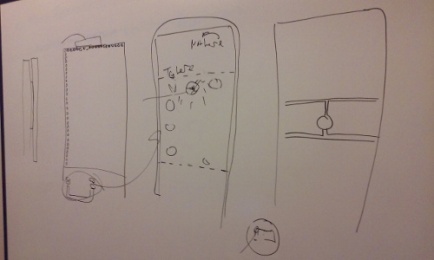
DESIGN 2:
A door that can be opened using either available handle. This door was essentially the opposite of the previous design, The idea was to create a door that had two handles on either side of the door which would open either way, depending on what handle was turned. The door would work by using (most likely hydraulic) door hinges that were all fired when the door was closed. When someone turned a handle, the hinges on that side of the door would retract into the door, allowing the door to swing openly. Another idea was to use a track system that allowed the door to be opened either way, with the hinges traveling along a track. This prototype was also very resource and time intensive, and would most likely be very expensive to implement.
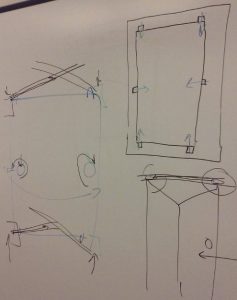
DESIGN 3:
This design was much simpler in concept than the other designs. The idea was to create some sort of movable barrier that people had to interact with. The most prominent idea was to impede people with a “limbo bar” that they could move up and down. The purpose of this would be to examine people’s willingness to interact with an object that wasn’t theirs. In the breach experiment, we saw that most people were unwilling to physically move the ladder, even though it was blocking their way and there were no explicit instructions for them not to move it. This would be a simple prototype that would guarantee people would interact with it. They have two options: either duck or limbo underneath the bar, or move the bar above their head and pass through more easily. The “limbo bar” prototype is pictured to the right.

Here is our whiteboard after our brainstorming session:
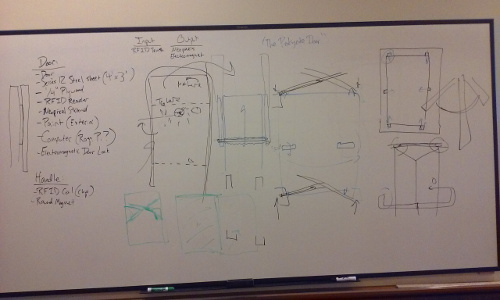
We decided -after some consultation with Joo- that our best option was to develop a prototype based on Design 3, the limbo bar.
PROTOTYPING:
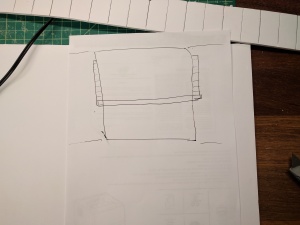
Pictured above, you can see the drawing of our limbo bar prototype. The idea was to create the entire prototype out of foam core. There were two benefits to this:
- Making the only material foam core made building the prototype very simple and low-cost.
- Using foam core as supports for the limbo bar took advantage of its potential flexibility, and the low durability associated with it. As you will see below, our prototype is essentially being hung by sheets of paper (the idea was that any tug downwards would destroy the prototype). Our hypothesis was this: We can hang this limbo bar by a few sheets of paper and have it survive a full hour of people passing by.
Pictured below, you can see the process of cutting the limbo supports. Strips of foam core were cut into lengths. The lengths were then marked every even inch on one side, and every odd inch on the other. Then, we cut into the foam core through the first layer of paper and through the foam center, leaving the paper on the other side intact. This was repeated on both sides. The result is a flexible length of foam core that gave the user the ability to lift the limbo bar above their head, while preserving the fragility of the prototype (at any point the only thing holding the limbo bar is a sheet of paper).
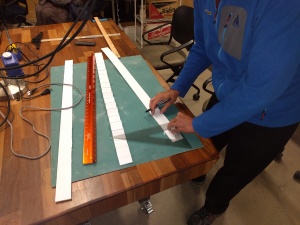
Finally, lengths of foam core were hot-glued together to match the width of both open doors in the ATLAS lobby. Two supports were hot glued on each side of the limbo bar. Originally, we were going to have the limbo bar supported by one support on each side, but we found out that this would cause the limbo bar to tilt forward, as opposed to being held straight.
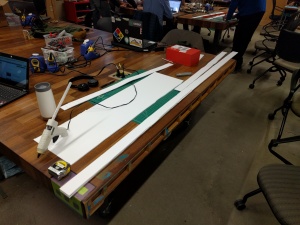
FINAL:
After a failed attempt to document our experiment using video we decided to recreate it again at the same location. We fixed our limbo bar to make it steady on the frame door adding more tape on the ends above it. Arrow up signs were put on both sides of the limbo bar as a signifier indicating the bar’s ability to be lifted above the head
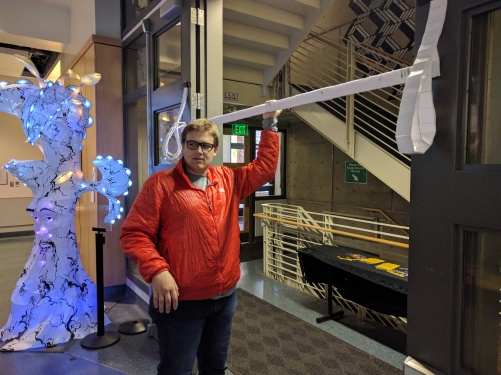
We asked a curious passerby (after wondering if this was for a class) to pose next to the bar, demonstrating both scale, and how to use it.
We established two different heights: One at barely five feet off the the ground where most people were able to pass by under easily. On the second lowered the bar to about three and a half feet, which proved much more difficult for people to navigate.
Many people were curious about the bar. Several people stopped to examine the bar and what was holding it up. There were many cases of redirection: people choosing other ways around, rather than interacting with the prototype. We found the most common behavior was to hesitate and finally duck underneath the limbo bar. Unfortunately there were no “natural limbos” during the experiment. However, the prototype lasted for the entire hour in the middle of the doorway, validating our hypothesis.
REFLECTION:
Based on the results of both experiments, we found that people would generally rather be inconvenienced than interfere with obstructions in there way. There were a few notable instances of people moving ladders out of their way, but our prototype was not torn down during the hour it was up (both hours actually, since we lost the recording from the first experiment). For many people these were unconscious decisions: gut reactions to strange obstructions blocking their way. We believe that because these were mainly decisions decided upon without thinking that it reveals something deeper about how humans operate in the world around us. We saw people showing respect to the environment around them, no matter how late we made them to class.
REFERENCES:
There were no direct references to report during this process, although both Sergio and I found ourselves independently influenced by the pranks perpetuated in the 50’s and 60’s by Situationists. The Situationists were instrumental in the formation of the punk genre which continued to spread many of their ideas. Famous Situationist Jamie Reid created much of the artwork for integral punk band, The Sex Pistols.

